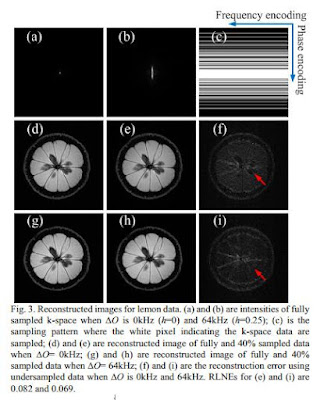Xiaobo Qu sent me the following:
Dear Igor,
Thanks for maintaining your blog to share the progress on sparse signal processing and related fields. I really got lots of meaningful information from this blog.Recently, we did one one work on spread spectrum compressed sensing MRI using Chirp pulses. The original spread spectrum compressed MRI was previously published in "G. Puy, J. Marques, R. Gruetter, J. Thiran, D. Van De Ville, P. Vandergheynst, and Y. Wiaux, Spread spectrum magnetic resonance imaging, IEEE Trans. Med. Imaging, vol. 31, pp. 586-598, 2012." , which reduces mutual coherence between sensing and sparsity bases. Second order shim coil is used to produce the spread spectrum effect. In our work, we produce the spread spectrum using Chirp pulses.It controls the energy distribution of k-space in MRI more easily by setting chirp pulses bandwidth.Here is the information of this paper.Authors: Xiaobo Qu, Ying Chen, Xiaoxing Zhuang, Zhiyu Yan, Di Guo, Zhong ChenAbstract: Compressed sensing has shown great potential in reducing data acquisition time in magnetic resonance imaging (MRI). Recently, a spread spectrum compressed sensing MRI method modulates an image with a quadratic phase. It performs better than the conventional compressed sensing MRI with variable density sampling, since the coherence between the sensing and sparsity bases are reduced. However, spread spectrum in that method is implemented via a shim coil which limits its modulation intensity and is not convenient to operate. In this letter, we propose to apply chirp (linear frequency-swept) radio frequency pulses to easily control the spread spectrum.To accelerate the image reconstruction, an alternating direction algorithm is modified by exploiting the complex orthogonality of the quadratic phase encoding. Reconstruction on the acquired data demonstrates that more image features are preserved using the proposed approach than those of conventional CS-MRI.Available at : http://arxiv.org/abs/1301.5451Thanks for sharing.Best regards,XiaoboXiaobo QuPh.D., Assistant ProfessorDept. of Electronic Science, Fujian Provincial Key Laboratory of Plasma and Magnetic Resonance, Xiamen University, China
Postal Address: P.O. Box 979, Xiamen University, Xiamen, Fujian, ChinaOffice room: Jiageng Building #4-610Postal Code: 361005
Join the CompressiveSensing subreddit or the Google+ Community and post there !

No comments:
Post a Comment